In my previous article, I discussed the on-going conservation work taking place at Iztuzu Beach, a place of magnificent natural beauty, and an integral location for Loggerhead Turtle (Caretta caretta) nesting. I first visited Dalyan and Iztuzu Beach when I was around 7 years old, and the place made a deep impression on me, contributing to a love of wildlife and interest in conservation.
At the start of the year I began to research turtle conservation projects in the Mediterranean and quickly became frustrated at the astronomical fees of Gap-Yah-orientated programs in Cyprus and Greece that involved little hands-on interaction with the turtles themselves. With my past experience as a child visiting Dalyan, I decided to look for conservation volunteering options in the area, and quickly came across DEKAMER – set up and managed by Pamukkale University, headed by Professor Yakup Kaska and coordinated by Doğan Sözbilen.
Beginning in May, I was lucky enough to spend two months volunteering at DEKAMER, living on-site at Iztuzu and helping with the day-to-day running of the hospital and visitor centre, as well as nightly research and conservation patrols. With a prohibition on permanent structures on the beach for conservation reasons, the facilities are understandably basic but more than suitable: kitchen, shower, washing facilities and detergents, clean bed-linen, 2 air-conditioned sleeping containers, outdoor sleeping tent, satellite TV, WiFi and a samovar boiling day-and-night make for an austere yet pleasantly comfortable environment where one can really appreciate the stunning natural beauty of the beach and its surrounding landscape.
Arriving at the start of the month I was told I was the first volunteer to arrive, meaning I had a very thorough introduction to the work done by DEKAMER. The first few days were incredibly demanding, the nesting and tourist season had both begun but the volunteering season hadn’t quite hit full flow; being the only native English speaker at that time meant that visitor centre hours were incessant, with little respite between tour groups, let alone time for a glass of ҫay. Nevertheless, the high workload meant I quickly picked up anatomical, dietary and reproductive knowledge of Caretta caretta (Loggerhead Turtles) and Chelonia mydas (Green Turtles), as well as natural and human threats, conservation projects, and most importantly, the names and stories of the turtles in the hospital.
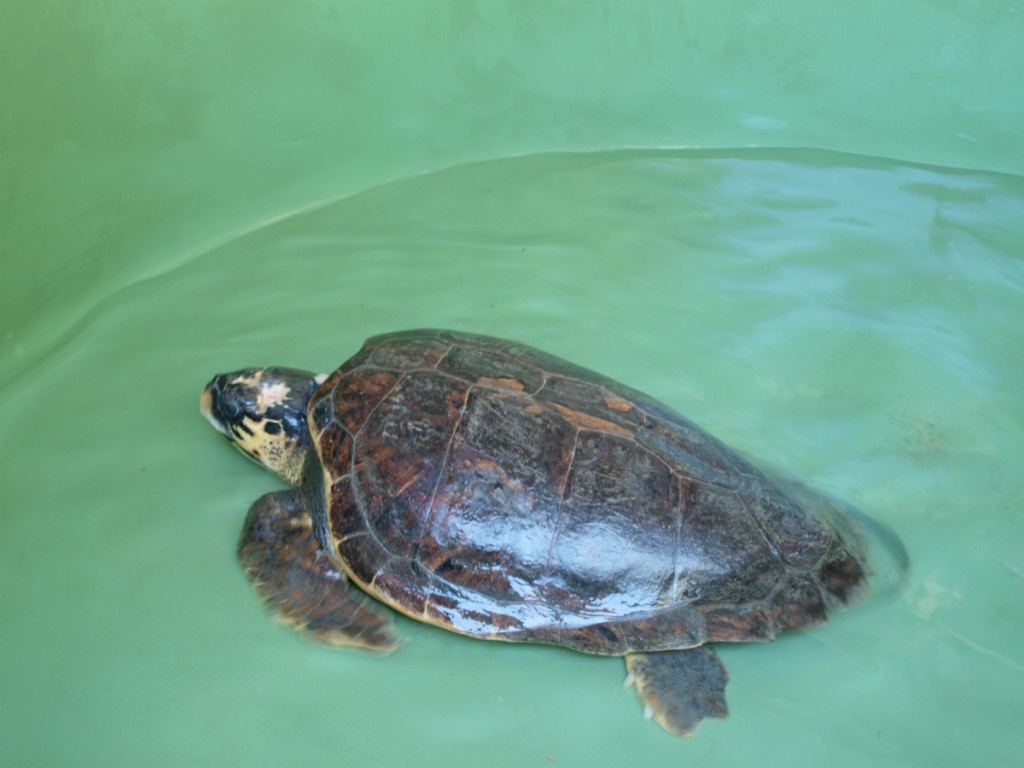
When I arrived there were 6 resident turtles in the hospital. Three Loggerheads: Osman; fittingly-named for his ferocious appetite and rotund shape, Neslihan; the oldest resident at 65 years old, and Tabiat; a young Loggerhead with suspected brain damage. The remaining residents were three Green Turtles: Ekodösd; a turtle who was forced to have a flipper amputated as a result of damage caused by fishing line, Fethiye; a lively juvenile turtle with a rare condition where trapped air bubbles under her shell prevent her from diving, and İlsu; a flamboyant 35 year old turtle with a deep cut to one of her flippers.
With both female and male turtles espeically prone to injury during the breeding and nesting season, more turtles arrived during my time including three Loggerheads named Tugay, Fatoş, Gizem İzmir and another Caretta caretta called Didim who unfortunately died from severe wounds the day after she arrived. This past weekend a month after finishing my volunteering program at DEKAMER, I returned for a few days extra, and in just 4 weeks of being away another 8 turtles had been brought in, likely influenced by the high levels of tourist activity in July.
The cause of injuries/illnesses to the turtles include feeding by humans, propeller trauma, fishing line entanglement, fishing hook ingestion, and direct head-trauma, as was the case with Neslihan, Tabiat and Gizem İzmir – injuries most likely caused by fisherman attempting to kill them. Since opening in 2009, DEKAMER has had over 100 turtles come in, with 70% able to return to the wild, a very high figure given the seriousness of some of the injuries. As turtles are solitary animals they are all kept in individual tanks of varying sizes, with small ones for hatchlings and juveniles, all the way up to 5m diving tanks for turtles that are close to completing their rehabilitation.
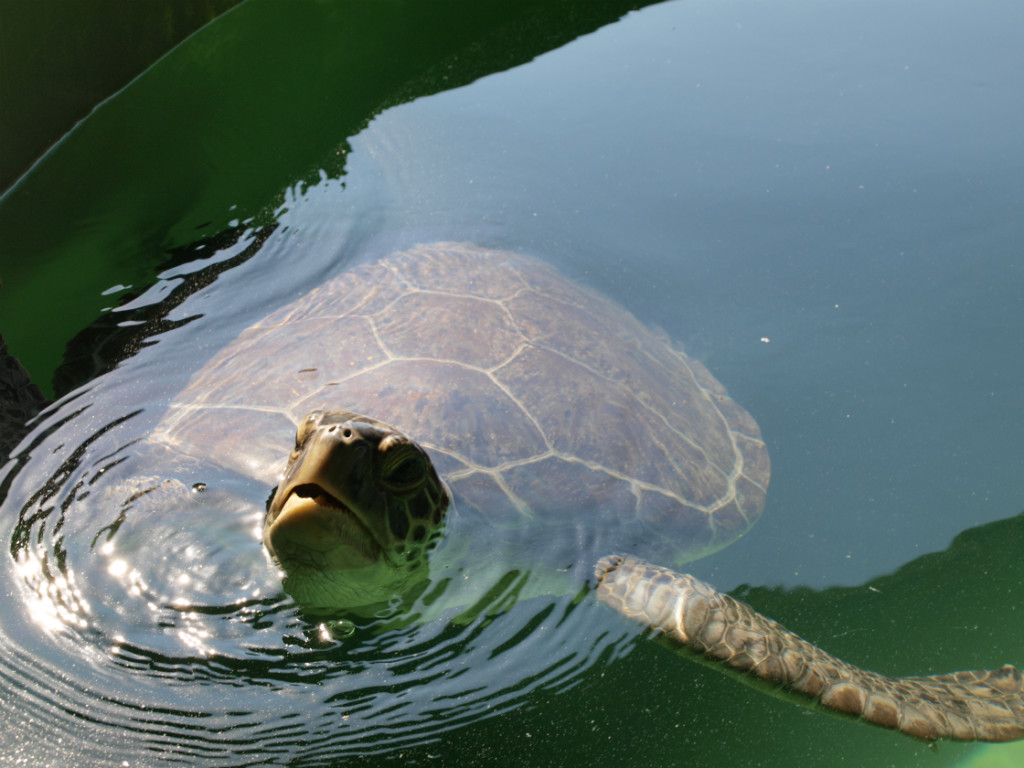
The hospital sees a vast amount of local and foreign visitors, the latter being predominantly from the UK, the Netherlands, Germany, France, Denmark and Finland, with one family coming all the way from India, specifically to visit DEKAMER. Groups come in all sizes with many independent travellers travelling alone or in couples, as well as large tour groups coming from Dalyan, Fethiye, Marmaris and Bodrum.
After a week of intensive tour-guiding in the visitor centre, my enthusiasm came to haunt me when I woke up one morning to find my voice completely gone. Fortunately, this coincided with the arrival of a number of new volunteers, allowing my tired vocal-chords to have a much-needed rest. The new volunteers came from all walks of life; a number of Turkish biology students coming for undergraduate summer projects or PhD theses, as well as international volunteers from Estonia, Australia, England, Wales, Hong Kong, France, Ireland, Japan, Norway, Germany, Italy, and the Philippines.
With breeding and nesting season in full-flow, nightly beach patrols became more uniform and regular: three groups of three would leave at half hour intervals, starting at 21:30, with each group patrolling a designated area of the beach until 03:30. Choosing to either sleep for two hours on the sunbeds at the end of the beach or continuing to plough on, the teams resume the patrol at 05:30, returning to the centre in time for breakfast at 09:00.
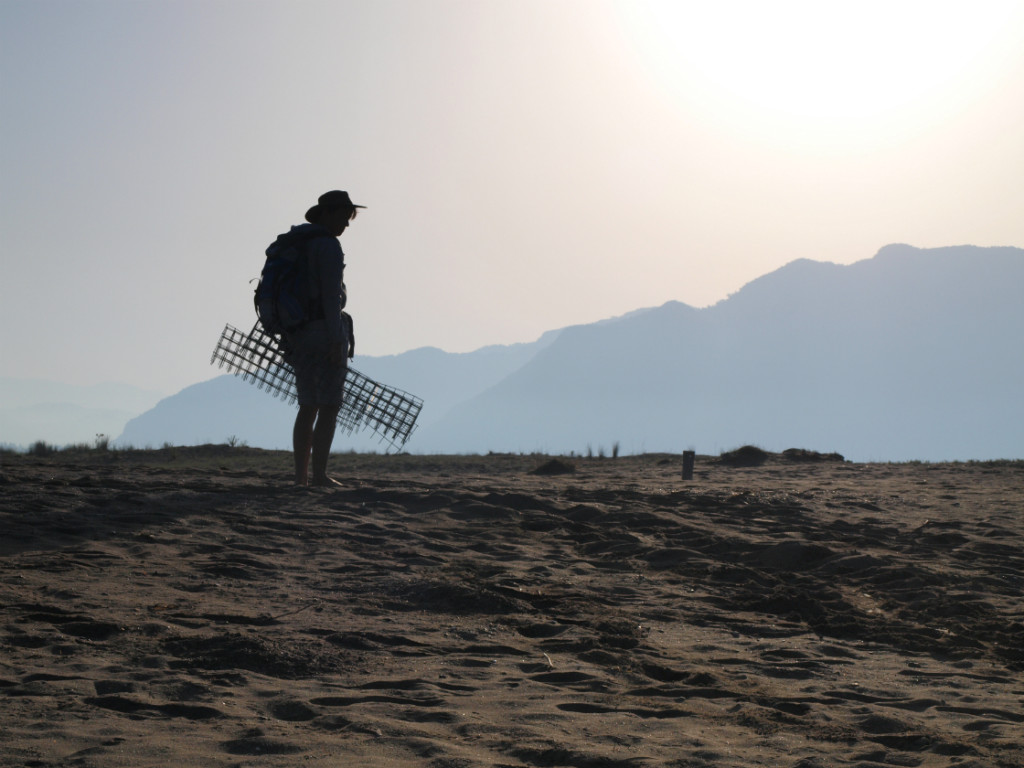
The groups patrol the beach at the point where the ‘wet’ and ‘moist’ sand meet (just above where the waves crash onto the sand), looking for turtle tracks coming from the sea. In order to prevent scaring any turtles, this stage is done in complete darkness, a tall order when there is no moonlight! Upon locating turtle tracks, the teams check to see if there is a return track to the sea, if there isn’t it means the turtle is still on the beach, and particular care must be taken not to disturb it. Quite often tracks are false alarms in regards to the locating of nests; only ¼ tracks along the beach lead to nests, with turtles doing multiple recces to test the gradient and type of sediment, temperature and safety of the beach.
When a turtle is found nesting, volunteers must stay completely silent and still while the turtle is digging its nest. Once the turtle begins to lay its eggs it enters a trance-like state during which volunteers are able to take straight and curved length and width carapace (shell) measurements, as well as checking for any abnormalities. We also check for identification tags, noting the number. If there isn’t a tag then once the turtle has finished laying and covering the nest, a tag is attached to the front-right flipper, and other devices such as temperature and depth recorders can be attached for research purposes. The whole nesting process can often take over an hour, with some turtles walking for hundreds of metres or digging multiple test nests until they finally settle on a location for the actual nest.
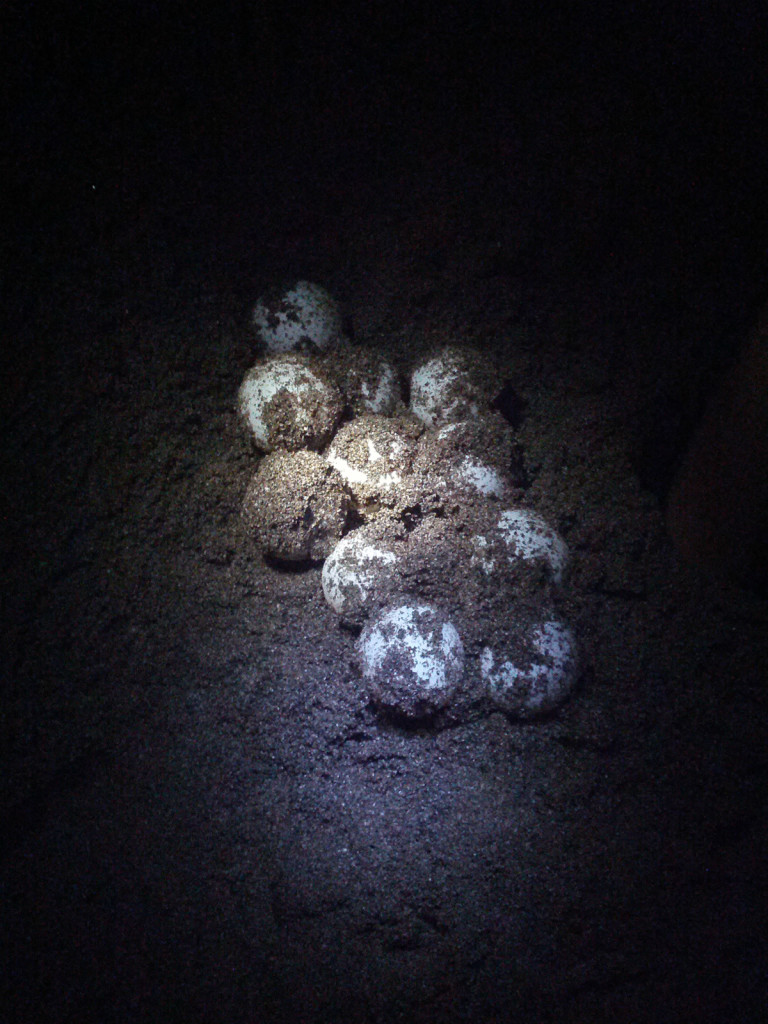
The whole process is enchanting: the precision with which the females blindly dig a 60cm deep nest-chamber with their rear flippers is mind-blowing, as is the meticulous multi-staged covering method to camouflage the nest from natural predators like foxes and badgers.
Once the turtle has returned to the sea, volunteers and biologists locate the exact location of the nest chamber by using an iron pole to test the density of the sand. After this the groups take numerous measurements: distance of the nest from the sea, distance of period of wet sand, moist sand and dry sand, distances from the nest to the measuring poles (there are 450 poles at 10m intervals all along the beach), measurements of interior and exterior track widths, as well as taking GPS recordings of the nest locations.
Some nests need to be relocated if they are less than 10 metres from the sea, and at some unprotected areas of the beach, if they are less than 20 metres from the sea. This involves carefully digging up and removing the eggs from the original nest and constructing an identical nest further from the sea.
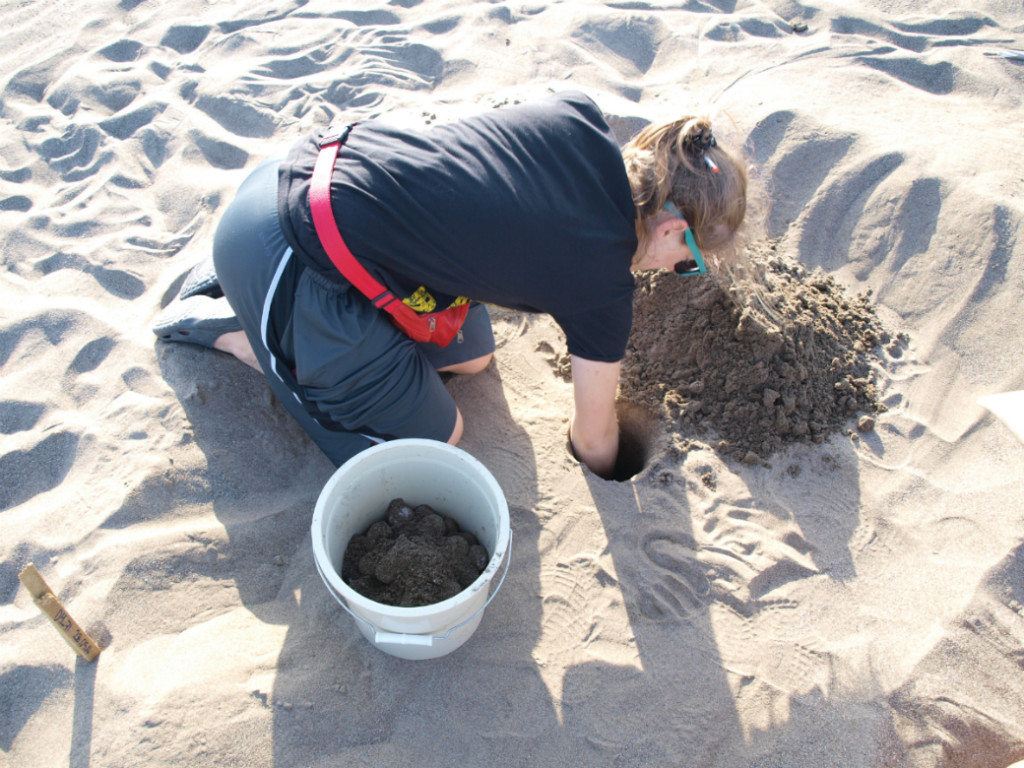
The next stage is when the real manual labour starts – volunteers and staff dig and place 1m² protective cages, and side cages 20-25cm under the sand , with special pyramid-shaped cages also placed on nests that are located at the two ends of the beach near the sunbeds. Irons pegs and plastic ties are used to secure the cages which are then covered by sand to hide their locations, and a nest number is given.
The night patrols from May until June are during the nesting period, with July a transitional period with both nesting and hatching, and August-September as the hatching period. During the latter period, nest data records are analysed to determine which nests should have had all of their eggs hatch. When these are found, patrol teams remove the cages and excavate the nests, which often includes meeting a number of hatchlings on their way up to the surface! Once all remaining hatchlings have been collected and released into the sea, volunteers and staff begin to check the unhatched eggs – a job not for the faint-hearted. Eggs are opened and analysed to determine the stage of embryonic development inside the egg; early-development, mid-development and late-development, with samples often being taken for genetic analysis. This data (as well as any instances of unfertilised eggs) is all recorded, along with the nest diameter, wet and dry sand depths – information important to the research work of DEKAMER. The teams also count the number of hatchling tracks that reach the sea, and bring any hatchlings found on the the beach in the morning back to the centre, so they can be released the following night when the sand temperature is cooler.
The work is incredibly rewarding, seeing hatchlings leaving nests that we have caged and protected, slowly and warily making their way to the sea to begin their great adventure. With the lifespan of Loggerheads averaging 100-120 years and Green Turtles able to live up to 200 years, it’s certainly a long adventure indeed!
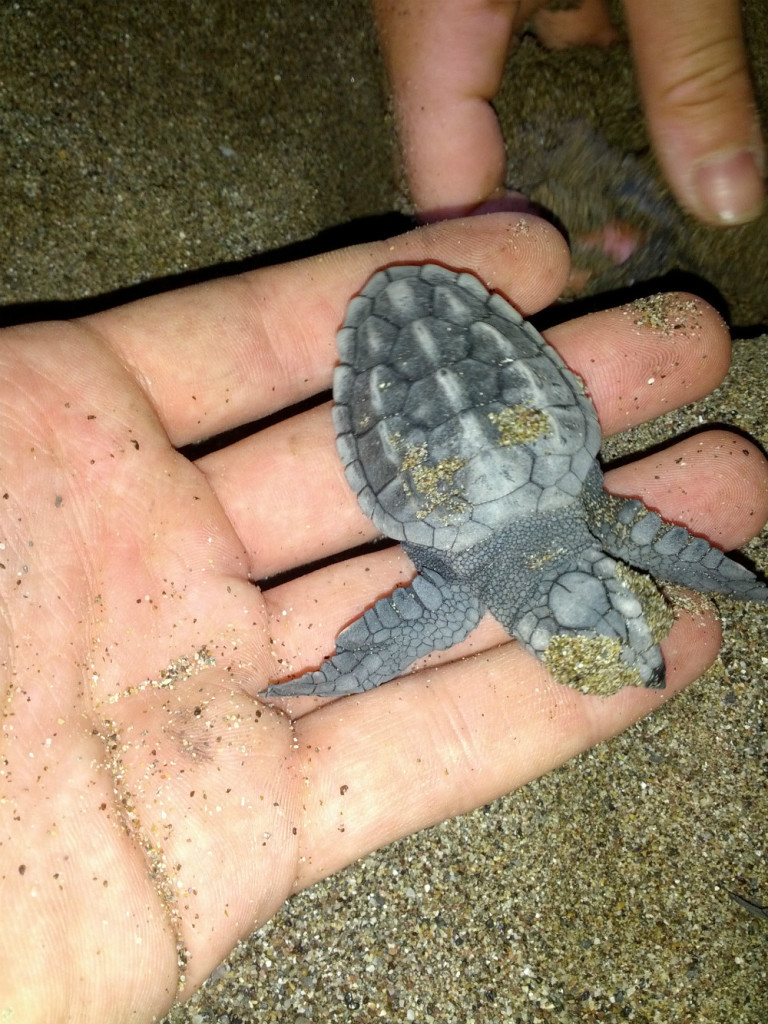
All in all the night patrols are very tiring and physically demanding, but we often found ourselves hitting a strangely euphoric state in the mornings after a hard nights work. It felt like the exhilarating moment when you leave a club after a hard night raving until 7am – only you’re riding on a natural high and are greeted by a beautiful Mediterranean sunrise rather than a cold metropolitan morning. The whole night-patrol experience is truly wonderful; the camaraderie with your team – the jokes, the mishaps, the panicked frenzies when you see an untagged turtle about to enter the sea, and the entrancing egg-laying process itself – all under the beautiful starlight of the Milky Way, undisturbed by light pollution.
DEKAMER also places a great deal of trust in their volunteers: after 3 night patrols with an experienced staff member or biologist, you’re deemed ready to go on a night patrol without an ‘expert’. This show of faith really helps volunteers venture out of their comfort zones, allowing them to live truly memorable experiences. In true Turkish fashion, the staff at DEKAMER have no qualms about volunteers getting involved with all manner of tasks in and around the centre; within a few weeks us volunteers were taking part in dissections of deceased turtles, taking blood samples, administering medication, and even assisting with an operation on a severely injured turtle. Whether volunteers are studying biology or are simply there through a passion for wildlife, everyone is encouraged to get involved. The centre has a real communal feel, with a work rota that ensures volunteers all contribute to cooking and cleaning, as well as turtle rehabilitation, visitor centre information and the nightly research and conservation patrols.
Compared to many countries, Turkey has a distinct lack of volunteering opportunities, and for those who like to dedicate some of their spare time to assisting with charitable projects, this can be quite frustrating. DEKAMER provides a chance for people to get involved in hands-on wildlife conservation work for endangered marine turtles, while simultaneously meeting like-minded people and building great friendships. Volunteers are asked to provide an affordable €200 monthly fee to cover the costs of accommodation and food, and being in Turkey you can be assured that you won’t go hungry, with a very generous Turkish breakfast and large amounts of fresh organic ingredients to use when making lunch and dinner.
If you feel like the hustle and bustle and relentless pace of Istanbul is getting a bit too much for you, if you have a love of wildlife and want to make a difference, or if you simply want to challenge yourself with something new, then volunteering at DEKAMER is for you. The beautiful setting on the south-west coast of Turkey, the positive experiences with both fellow volunteers and visitors – not to mention the fascinating and valuable work protecting turtles – made for a truly memorable experience, one I am never going to forget.
If you’re interested in volunteering at DEKAMER, you can find more information on their website.
Timur Jack-Kadıoğlu is a contributor for Yabangee.










Hi. The link that you have provided is no longer working so I couldn’t get some necessary info. Could u please help 🙁
Also, I was wondering how old you have to be to volunteer. Was it 17?
Hi Deniz. It would appear that their link has changed. We’ve gone in and updated the piece, but you can also just go to: http://dekamer.org.tr/
Not sure about the age requirements, so hopefully they can get you sorted if you reach out to them.